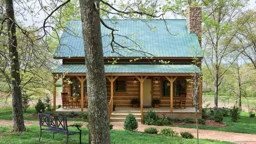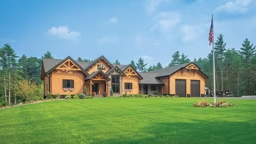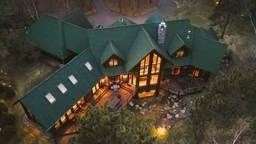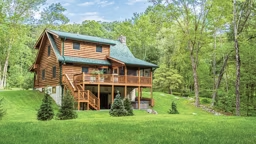Like most modes of artistic expression, the origin of timber framing is not a new one. It has deep roots in history, dating back centuries. But like art, this beautiful form of construction is constantly evolving, both in accordance with the artist's personal tastes and with the times. The history of timber framing in North America takes its cue from the continent's neighbors to the east and west.
For example, 16th-century Europe saw its forests rapidly diminish. To curtail the effects of deforestation, regulations regarding the harvesting of trees were implemented and strictly enforced. However, skilled craftsmen wielding specialized tools devised intricate systems of joinery in response to these regulations. Gaps created between posts were filled with stick fragments, rock rubble and clay—thus requiring less wood and falling within the guidelines. Unfortunately, forest depletion continued, and countries such as England and France mandated that architecture be built almost exclusively of stone.
On the other side of North America, timber framing had taken hold of Japan. Not only were its clean, simple lines aesthetically consistent with Japanese style, it was also economical and had an amazing propensity to withstand the severe conditions, such as earthquakes and typhoons, to which Japan is prone.
Not to be outdone, in the 16th century, North America embraced the craft as well, and it flourished for generations. Unfortunately, cost, demand, depleting resources and the fickle nature of changing times caused the style to go out of favor throughout the next several centuries, making way for more quickly built stick-frame homes that could be constructed with the help of less-skilled labor and at a lesser cost.
After a brief resurgence in the early 20th century (thanks to the Arts and Crafts movement and people like Frank Lloyd Wright and Gustav Stickley), the economical and environmental sensibilities of the mid-1960s back-to-nature counterculture spawned a renewed interest in handcrafted goods and alternative building methods. Timber framing came back on the architectural scene in a big way. By the '70s, the post-and-beam style was once again in favor, and the rejuvenated industry continues to thrive with each passing year.
Of course, even time-honored tradition isn't immune to the infiltration of the Information Age. If the industry is to survive, it has to use the resources available to it. Web and magazine advertising have opened up the marketplace, and according to a 2000 sales and marketing survey sponsored by the Timber Frame Business Council, interest has gradually but steadily increased since 1996.
According to Susan Broadhead from Goshen Timber Frames in Franklin, North Carolina, there is a significant increase in the demand for timber frame homes. "Ten years ago, most people didn't even know timber framing was an option for quality residential construction," she says. "Now people come to us saying, 'We know what it is, and it's what we want.'"
As part of the influx of technology in today's society, timber framing companies have maintained a delicate balance between incorporating time- and money-saving techniques into the handcraftsmanship that interests a buyer in this type of home in the first place.
"I believe there will always be a traditional element to our industry," says Ross Grier of Cascade Joinery in Bellingham, Washington. "But as it grows, there will not only be opportunity, but also necessity, to use modern materials and methods, such as kiln-dried wood, automated machinery and hybrid designs."
In fact, hybrid homes—those combining traditional timber framing with other forms of architecture—are generating a great deal of interest among prospective buyers.
Hybridization is only one of the ways in which the industry is changing to keep up with the times. As an art form, some timber framers choose to build only a handful of homes each year. But from a business angle, companies are finding they have to (and want to) keep up with home buyer demand.
"Being a young industry with an old craft means we are still getting our marketing and business skills honed," says Mary Sorenson of Thistlewood Timber Frame Homes of the Southwest.
Although projections are that the industry will continue to grow, Susan cautions that the expansion should be a gradual process. "All of the companies I know, including my own, have increased capacity in order to take on more clients each year," she says.
For many, emotion, not price, may be the deciding factor in their decision to build a timber frame over a conventional home. A timber frame home is an investment in much the same way as other works of art. You may buy them because you hope their value will increase as the years go by, but first and foremost, you buy them because you love them.
And that is an investment that is not meant just to be appreciated, but celebrated.











